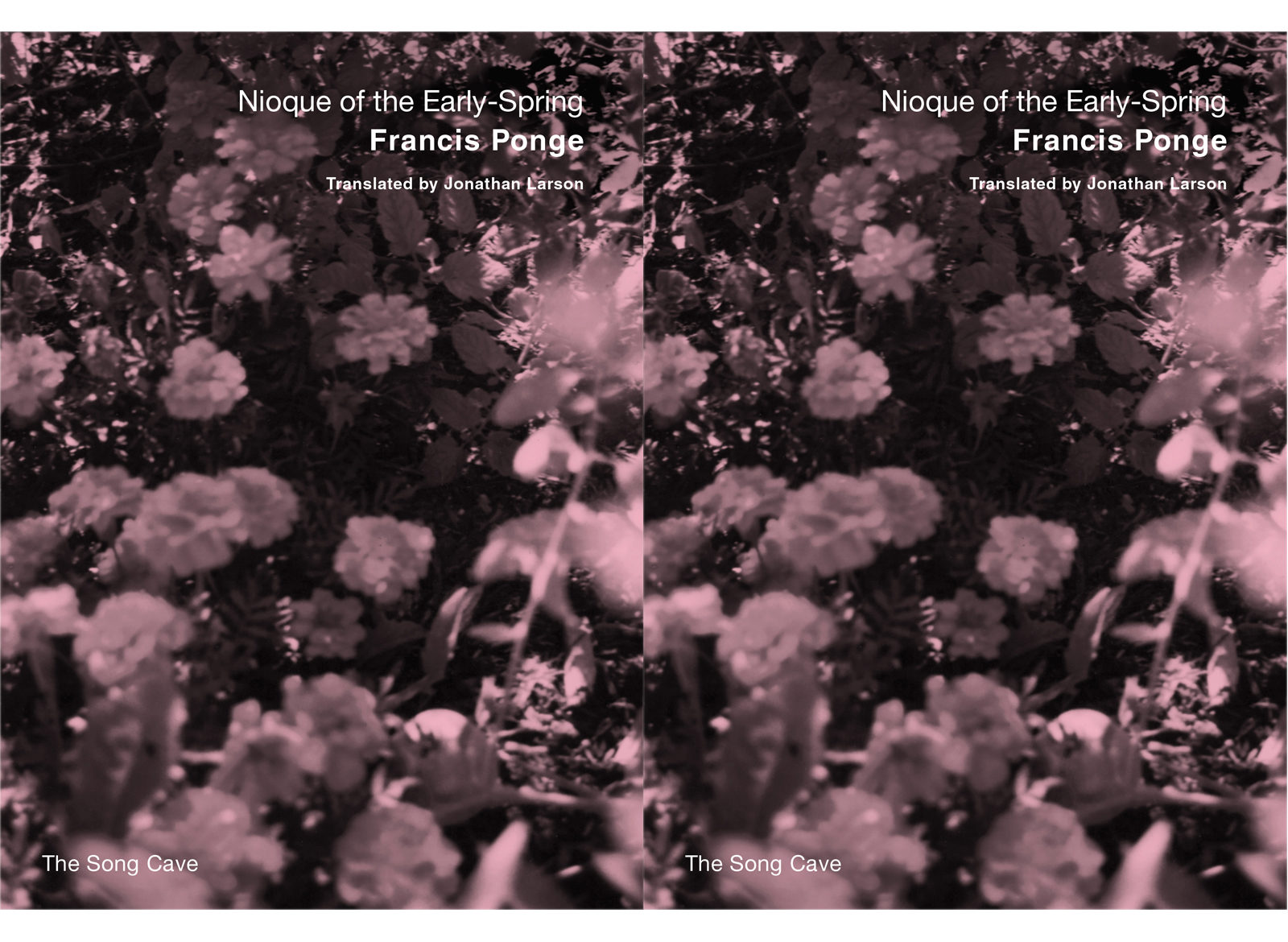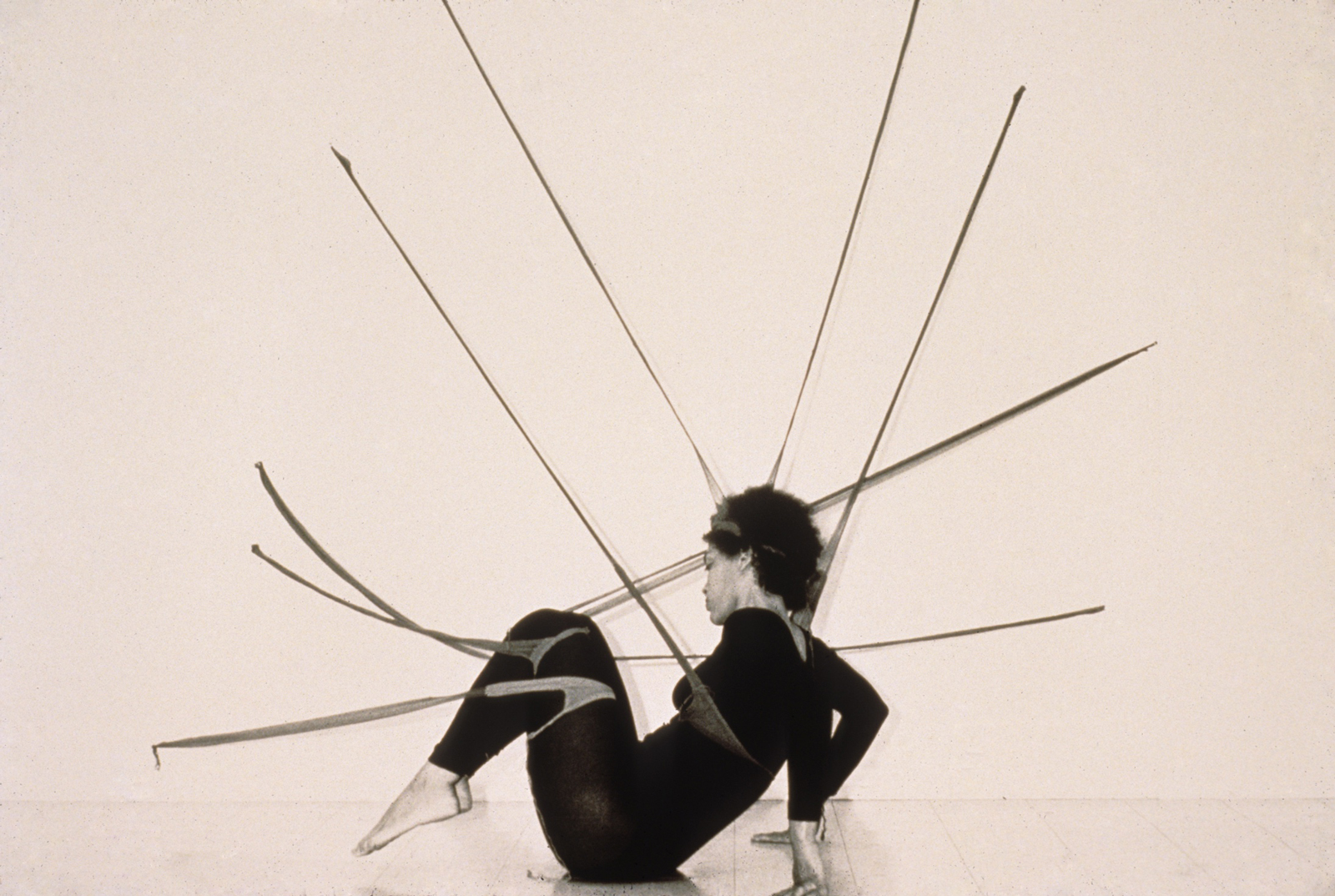Text & Interview: Alec Coiro
All Images Courtesy of The Song Cave
Book Cover Photo: Mary Manning
How do you set out translate knowing that so much will be lost in translation? And must not this “Sofia Coppola dilemma” grow exponentially when the subject is poetry. Recently, Jonathan Larson soldiered through this task of sorting through what he calls “dissensions and alliances in the tribe of words” in Francis Ponge’s volume of poetry entitled, Nioque of the Early-Spring.”
Stumbled upon by coincidence/fate, Larson found himself traveling with the book of French poetry literally close to his heart, and has now translated its musical structure into English. Originally written in the 1950s but with relevance to the French Radicals of ‘68 (and perhaps ‘18), Ponge created poetry in a style that (to my mind) recalls William Carlos Williams’s imagist evocations of the things of everyday life.
Larson was nice enough to talk to us about the book, and if you’re settling down to read it, I dare say his words here would serve as a fine companion. We talked about Ponge’s (and Spring’s) significance in a revolutionary context as well as Ponge’s thoughts on art in relation to revolution. Of course, the conversation dips from there into May of ‘68 in France. Larson helps us chart Ponge’s shifting association from surrealist to member of the Tel Quel group. And, of course, Larson also speaks at length about the translation as an artform and the challenges of translating Ponge in specific.
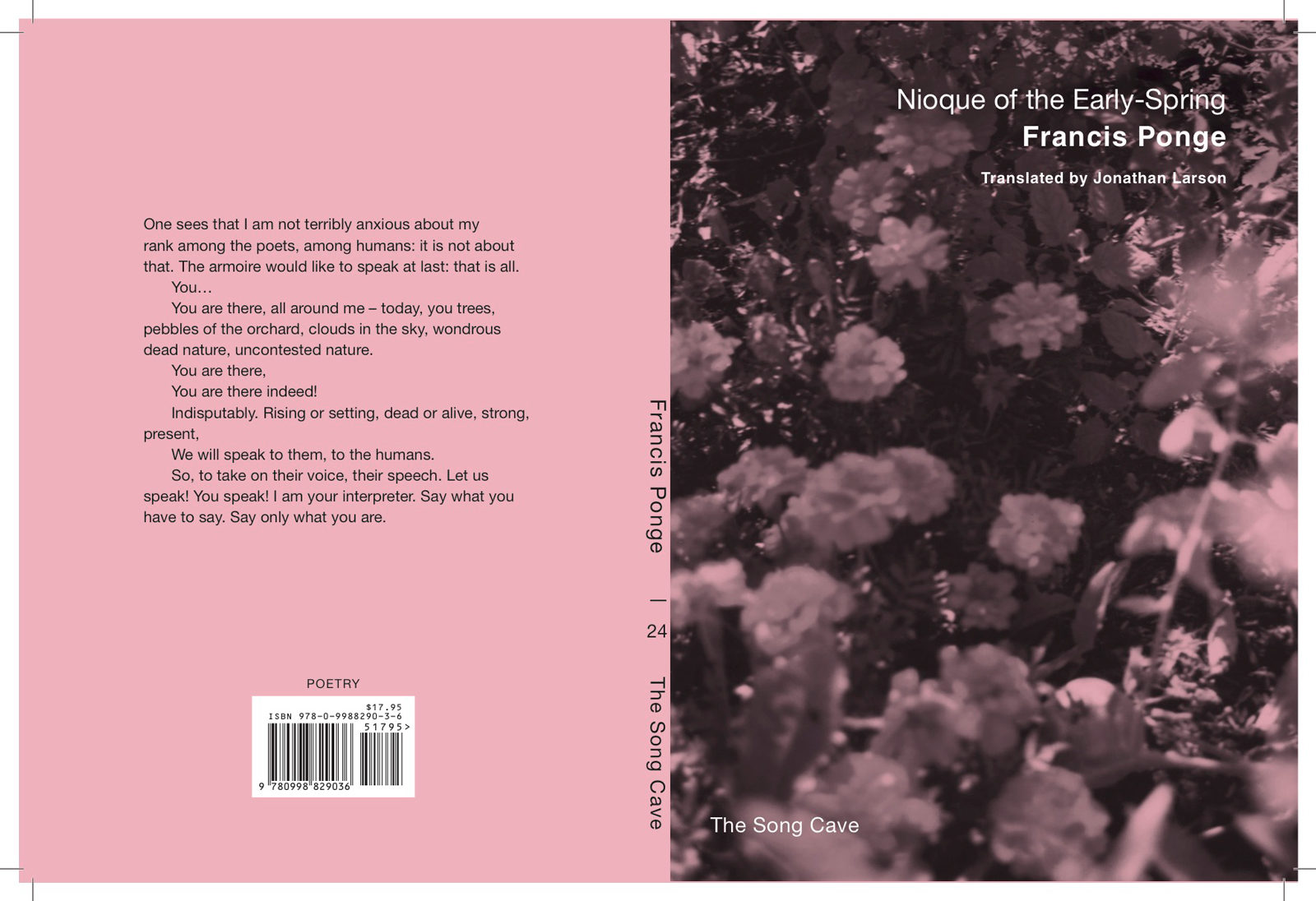
Why Francis Ponge? Why this particular book?
The most direct answer is that I came across this book while rooting around in the basement at the Strand, and it was one of those lucky finds when the right book at the right time leaves with you. It was slim enough to keep on me inside my coat that winter and so I read and reread, and it retained its charge. The book is structured similarly to a musical piece of 4 utterly distinct movements with interwoven and developed thematic phrases so that it takes on this wonderful disjunctive / conjunctive energy. It’s part poem, part history, part treatise, part manifesto, but all of it a document covering a series of days when winter turns to spring in the countryside of Les Fleurys, to claim a present that would rule over the past. In Ponge’s writing there is a singular knack for honing in on common denominators, for participating in the world of things, for tapping their elemental makeup, maybe even “doing science,” but cheerful, playful science. The methods are fully aware of the limitations of language insomuch as they could isolate anything like “the thing itself,” and return it then to its proper usefulness, as a medium to make poetry and art out of, and to experience that pleasure, its “relative satisfaction,” its sound, texture, and etymological substance.
From what I’ve read by and about Ponge, he sounds like the French answer to William Carlos Williams. Obviously, that’s reductive, but do you see any connection there, or is there a better English language poet or poets to give English readers a frame of reference?
Definitely. Even aside from the obvious parallels of WCW’s “no ideas but in things” and Ponge’s “on the side of things”—they both had painter’s eyes, were concerned with trimming back statements to their most concise expression, and professed political engagement. They both move between rhetorical registers and ones that are more spoken and idiomatic, between verse and prose to experiment with ‘new writing,’ though on the whole Ponge’s approach remains ‘classical’ where I think of WCW as ‘romantic,’ and along those same lines, I would read Ponge as favoring “distraction” (in Walter Benjamin’s sense of straying) in art, and identifying with the notion of the author as producer in a way that might have made WCW a little uneasy, who had really staked a claim in the artist as the individual visionary. Perhaps their most distinctive commonality lies in their open, positivistic approach toward their subjects, and a tongue-in-cheekiness, e.g. the riffing on Lucretius from Book I of Paterson (“No flesh but the caress!”) could have come right out of Nioque of the Early-Spring. Other objectivists such as Louis Zukofsky, George Oppen, and Lorine Niedecker also come to mind as kindred spirits of Ponge, for their fierce commitment to an organic formalism, to playful rigor, their enduring attentiveness to both the patterns and mechanics of words and the world, and for their clarity – like Ponge their readings of Marx formed a solid base which nurtured their poetics.
Is there a message in the timing of the release? There’s the springtime timing, but are you also employing spring as a revolutionary signifier?
Absolutely, I think this book is suggesting that the timing is the revolutionary signifier and vice-versa. It’s lucky to have a springtime release, given Ponge’s attunement to the rhythms of the natural world, so that when one reads the text it can feel at once very true to the world’s surfaces and its inner parts, or to put it simply, to read and feel the spring come on. In addition, having the book officially appear on May 1st, the International Worker’s Day, and on the 50th anniversary of the May ’68 uprisings provides for a charged backdrop. In hindsight Ponge found the first publications from Nioque of the Early-Spring in May of ’68 in Tel Quel a fitting coincidence and explicitly linked the text to the protests and barricades of Paris that year in the foreword in the ‘83 edition. Even so, I think there’s always due cause to be wary of an overdetermined spring, and the emphasis is not so much that “spring is about to happen” but more so that “it’s on us to resay April (or October for that matter)”—a sentiment that echoes Ponge’s devotion to the arts as a vehicle to remake one’s world, anytime, all the time.
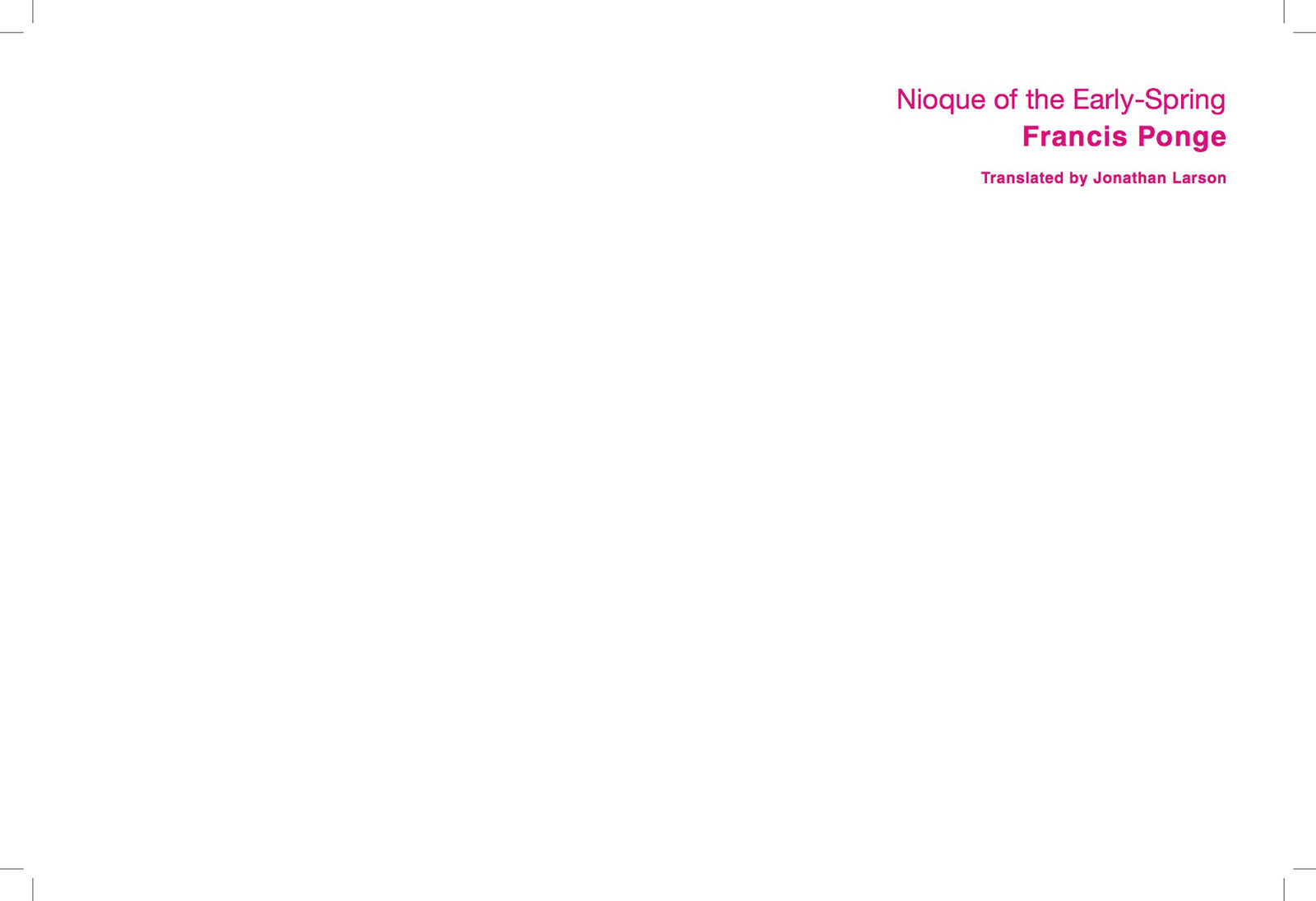
When one reads the text it can feel at once very true to the world’s surfaces and its inner parts, or to put it simply, to read and feel the spring come on.
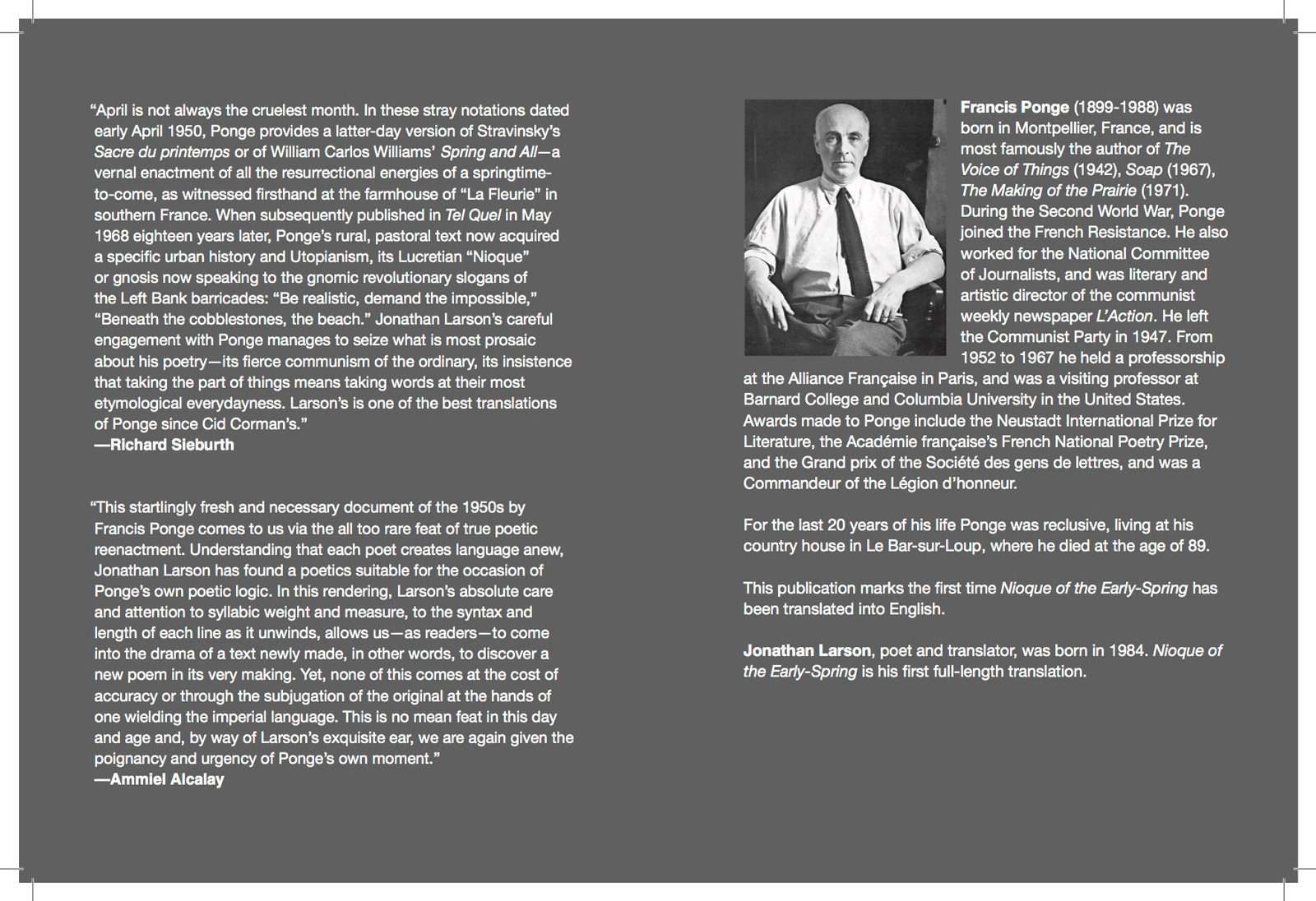
Written in the ’50s but then published in Tel Quel in 1968, did these poems and Ponge’s work generally have particular resonance with the artist and intellectuals in the French avant-garde associated with ‘68? I’ve seen him called the Le père spirituel de Tel Quel?
It’s an interesting timeline because Ponge occupied a unique space as one of the few poets of the Tel Quel group. George Braques and he came from another generation and tied them in genealogically with the Surrealists whose dissident fervor to art they were seeking to replicate. And it wasn’t really until Tel Quel that Ponge came to the acclaim that his name now enjoys, despite being widely read and admired among writers of the time such as Sartre, Camus, Blanchot, Bousquet, Paulhan, etc. This was also due to most of his work being published in limited run deluxe editions. In a sense, Ponge was a post-structuralist avant la lettre who had struck upon the impossibilities of describing and expressing, let alone to get to start talking about things, and yet the urge to speak, to speak about them would remain, an urge he viewed as coming from their “differential quality.” This meta-textual orientation caught the eye of Phillippe Sollers who had visited an exhibition of Ponge’s works and manuscripts at the Sorbonne and who then approached the latter to contribute to the review. Of course, Ponge (who noted that he had been the same age as the rest of the telquelians when he had written the pieces of his they published) decided that he had discovered Sollers, and Sollers, Ponge. In any case, Ponge’s poems and writings about poetry were featured in almost every issue up until Tel Quel’s Maoist phase, when the ranks split, due to their expanded sense of what the poem is and how it works, mirroring what Alain Robbe-Grillet and Sollers were attempting in narrative. Blanchot wrote about Ponge (in Charlotte Mandell’s translation) as one who “becomes the will that mediates between that which is rising slowly to speech and speech which is descending slowly to the earth, expressing not existence as it was before the day but existence as it is after the day: the world of the end of the world.” Here was a poet whose aim had been foreshadowing the Zeitgeist of ’68, to see a project through on its own terms.
What were the challenges translating these poems? Poetry seems like a uniquely challenging realm for a translator, and as such, I imagine each individual poet comes with his or her own unique set of challenges.
Indeed! It’s a task of giving up again and again, and then hopefully failing better. Translation involves encountering loss ahead of time, but also gaining a new sense of meaning from what’s lost that becomes a part of the new. I’d been reading Ponge for a while and playing with the idea of translating some, but couldn’t visualize how I’d make it out in one piece due to the etymological punning, the melting pot of idiomatic registers, and the wealth of definitions sourced from the Littré dictionary. To get Ponge right you’re juggling a moving matrix of texts. An instance of trademark density in this text comes up in part III of the book with “à un tel tour-de-main,” a pun on demain (tomorrow) which contains the preposition de (of) and main (hand), that literally means so much as “to such a turn-of-the-hand.” I tinkered around many times with how to most effortlessly reproduce the multiple meanings and concision before finally settling on “such a handturn tomorrow.” There’s so much deconstruction at the level of the French language in Ponge’s writing, e.g in a poem from La Rage de l’expression titled Notes taken for a bird: “Le mot O I S E A U : il contient toutes les voyelles.” Which amounts to so much as “The word B I R D: it contains all of the vowels”—except that it doesn’t. Luckily, there was no play at the vowel level in these poems, however there is one section where the second person plural (you) is identified with words where ‘r’ and ‘s’ predominate and verbs that end in the French conjugation with ‘e’ and ‘z.’ I went with ‘r,’ ‘s,’ ‘e,’ ‘t,’ for the second persons of ‘branchlets’ and ‘rodlets’ and for ‘e’ and ‘t’ for the verbs ‘leaf through’ and ‘foliate,’ a not quite as euharmonic version as the original’s amalgam of the sound and sense of budding and leafing, but my hope is that the interplay of pronunciation and spelling can be felt, and that the vitality of the poetry carries over to “create new dissensions and alliances in the tribe of words.”
